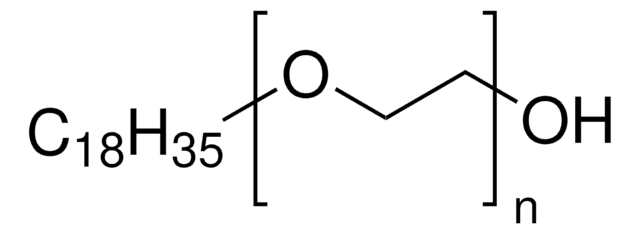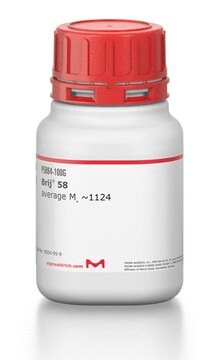Kluczowe dokumenty
436240
BRIJ® O20
average Mn ~1,150
Synonim(y):
Polyoxyethylene (20) oleyl ether
About This Item
Polecane produkty
opis
non-ionic
Poziom jakości
masa cząsteczkowa
average Mn ~1,150
metody
cell culture | mammalian: suitable
protein quantification: suitable
mp
25-30 °C (lit.)
HLB
15
ciąg SMILES
O(CCO)CCCCCCCC\C=C/CCCCCCCC
InChI
1S/C20H40O2/c1-2-3-4-5-6-7-8-9-10-11-12-13-14-15-16-17-19-22-20-18-21/h9-10,21H,2-8,11-20H2,1H3/b10-9-
Klucz InChI
KWVPFECTOKLOBL-KTKRTIGZSA-N
Szukasz podobnych produktów? Odwiedź Przewodnik dotyczący porównywania produktów
Opis ogólny
Zastosowanie
- as a detergent in medium A to prepare single detergent micelle aggregates
- along with phosphate buffer saline (PBS) solution as the receptor solution for terbinafine (TBF) for in vitro permeation studies of TBF-free base in porcine skin
- as a detergent to isolate detergent-resistant membranes from the mouse brain and to determine the distribution of major mammalian brain gangliosides, GM1, GD1a, GD1b and GT1b
Informacje prawne
Hasło ostrzegawcze
Warning
Zwroty wskazujące rodzaj zagrożenia
Zwroty wskazujące środki ostrożności
Klasyfikacja zagrożeń
Aquatic Chronic 2 - Skin Irrit. 2
Kod klasy składowania
10 - Combustible liquids
Klasa zagrożenia wodnego (WGK)
WGK 1
Temperatura zapłonu (°F)
>464.0 °F - Equilibrium method
Temperatura zapłonu (°C)
> 240 °C - Equilibrium method
Środki ochrony indywidualnej
Eyeshields, Gloves, type ABEK (EN14387) respirator filter
Wybierz jedną z najnowszych wersji:
Masz już ten produkt?
Dokumenty związane z niedawno zakupionymi produktami zostały zamieszczone w Bibliotece dokumentów.
Klienci oglądali również te produkty
Global Trade Item Number
| SKU | GTIN |
|---|---|
| 436240-100G | 4061832115542 |
| 436240-500G | 4061832115559 |
| 436240-5G |
Nasz zespół naukowców ma doświadczenie we wszystkich obszarach badań, w tym w naukach przyrodniczych, materiałoznawstwie, syntezie chemicznej, chromatografii, analityce i wielu innych dziedzinach.
Skontaktuj się z zespołem ds. pomocy technicznej







